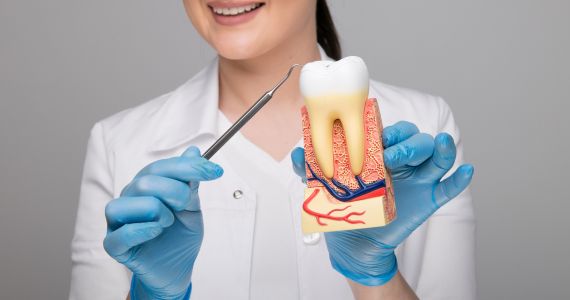

Root Canal Therapy for Tooth Pain in Yuma
Root canals often carry a reputation for being painful or frightening, but in reality, they are an essential part of maintaining good oral health. In fact, a root canal could save your tooth and help you avoid more significant dental problems down the road. If you’re in Yuma and experiencing discomfort in a tooth, you may be wondering about your options. In this article, we’ll dive into the details of root canal procedures in Yuma, explain when they are necessary, and answer the most common questions to ensure you feel confident and informed about your dental care.
What is a Root Canal?
A root canal is a dental procedure used to treat infection at the center of a tooth. The “root” part of the tooth is where the tooth’s nerve and blood vessels are located, and when this area becomes infected or decayed, it can lead to serious pain and complications. The goal of a root canal is to remove the infected tissue, clean the area, and seal it to prevent further damage or infection.
Why Would You Need a Root Canal in Yuma?
There are several reasons why a dentist might recommend a root canal. Some of the most common causes include:
Severe Tooth Decay: If a cavity has reached the inner part of the tooth and is affecting the pulp, a root canal may be necessary to save the tooth.
Tooth Infection or Abscess: Bacteria can invade the pulp, causing an infection. This infection can lead to an abscess, which can be painful and result in further complications.
Cracked or Chipped Teeth: A cracked or fractured tooth can expose the pulp to bacteria, leading to infection and the need for a root canal.
Persistent Pain or Sensitivity: If you experience prolonged pain, especially when chewing or drinking hot and cold beverages, it could be a sign that the tooth’s pulp is damaged and needs to be treated.
Ignoring these symptoms or delaying treatment can lead to more severe complications, such as the need for tooth extraction. In Yuma, as in other areas, it’s crucial to see your dentist promptly to avoid these issues.
Our Clients

Sarah T
- Dental Care Patient

Mark L
- Dental Care Patient

Emily R
- Dental Care Patient
How is a Root Canal Performed?
Understanding the process of a root canal can help reduce any anxiety you may feel about the procedure. Here’s what you can expect during a root canal in Yuma:
Preparation: The dentist will take an X-ray of your tooth to determine the extent of the damage. They will then numb the area around the tooth to ensure you’re comfortable throughout the procedure.
Accessing the Pulp: The dentist will create a small opening in the top of the tooth to access the infected pulp and remove the tissue.
Cleaning and Shaping: Once the pulp is removed, the dentist will clean the inside of the tooth and shape it to prepare for filling. This step is essential to ensure the area is free from bacteria and properly sealed.
Filling the Root Canal: After the tooth is cleaned and shaped, the dentist will fill the cavity with a rubber-like material known as gutta-percha. This helps seal the space and prevent future infection.
Sealing the Tooth: After the root canal, the dentist will place a temporary filling to close the hole. Eventually, you will need a permanent crown or filling to restore the tooth to its full function and strength.
Benefits of Getting a Root Canal in Yuma
Many people may feel hesitant or fearful about getting a root canal, but there are several reasons why this procedure is incredibly beneficial:
Pain Relief: One of the main reasons people get root canals is to alleviate severe tooth pain. A root canal effectively removes the source of the pain by eliminating the infected pulp.
Saves the Tooth: Root canals are designed to preserve your natural tooth. By removing the infected pulp and filling the root canal, your dentist can save the tooth from extraction. This helps you avoid the need for implants or bridges.
Prevents Further Infection: If left untreated, an infected tooth can spread bacteria to other areas of your mouth, leading to more severe dental issues. A root canal stops the infection from spreading and helps protect the rest of your oral health.
Maintains Normal Function: After a root canal and proper restoration with a crown, the tooth can function normally, allowing you to eat, speak, and smile without discomfort.
How to Know if You Need a Root Canal in Yuma
Recognizing the signs that you might need a root canal can help you take action early. While the only way to be sure is by visiting your dentist, here are some symptoms that may indicate the need for a root canal:
Severe Tooth Pain: Persistent, intense pain, especially when chewing or touching the tooth, is a common sign of infection.
Sensitivity to Hot or Cold: Lingering sensitivity to hot or cold drinks and foods can be a sign of nerve damage.
Swelling and Tenderness: If you notice swelling in your gums near a particular tooth, or if the area feels tender to the touch, this could be an indication of an infection.
Darkening of the Tooth: A tooth that has become darker in color can indicate that the pulp has died or is severely infected.
Pimple-like Bumps on the Gums: Small pimple-like bumps that develop on your gums near a tooth can indicate an abscess.
If you’re experiencing any of these symptoms, it’s best to visit a dentist in Yuma who can evaluate your condition and recommend the appropriate treatment.
Root Canals in Yuma: What to Expect After the Procedure
Once your root canal is completed, you might have some discomfort as the anesthesia wears off. However, most patients experience minimal pain after the procedure. Here’s what to expect in the days following your root canal:
Mild Discomfort: You may experience mild soreness or sensitivity in the treated tooth for a few days. Over-the-counter pain relievers can help manage any discomfort.
Follow-up Appointments: If you had a temporary filling placed, your dentist will schedule a follow-up visit to place a permanent crown or filling to protect your tooth.
Proper Oral Care: Maintaining good oral hygiene is crucial to prevent future issues. Be sure to brush and floss regularly and follow any care instructions provided by your dentist.
Avoid Hard Foods: After the procedure, avoid chewing on hard foods or using the treated tooth for a few days to allow it to heal fully.